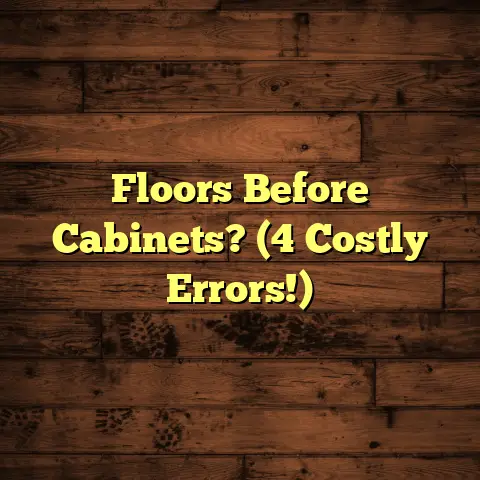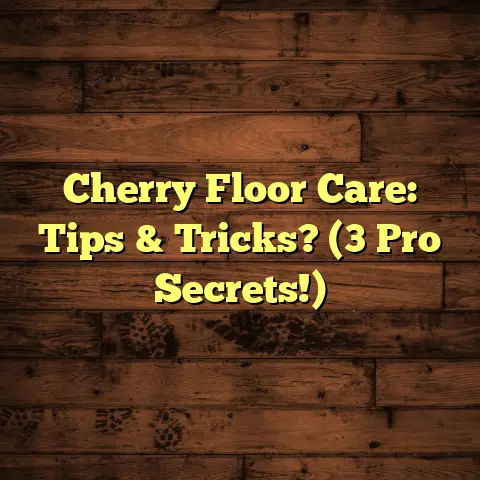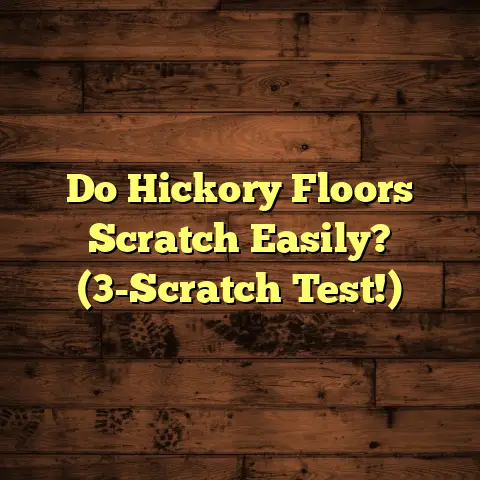Deep Cleaning Old Hardwood? (1-Day Fix!)
Ah, old hardwood floors. They’re like a warm hug for your home, aren’t they? They whisper stories of the past, echoing laughter and quiet moments. I’ve seen it countless times – the rich, inviting character of these floors just draws you in. But let’s be honest, time and life can take their toll. Dirt, grime, and everyday wear can dull that beautiful luster, hiding the natural beauty underneath.
That’s where deep cleaning comes in.
Think of it as a spa day for your floors – a chance to rejuvenate and restore their original glory. And the best part? I’m going to show you how to achieve stunning results in just one day. Trust me, the transformation is worth it. You’ll be amazed at how much brighter and more inviting your home feels. So, grab your cleaning gear, and let’s get started!
Section 1: Understanding Your Hardwood Floors
Before we dive in, it’s important to understand what you’re working with. Not all hardwood floors are created equal, and knowing the type and finish is key to choosing the right cleaning approach.
Solid vs. Engineered Wood:
-
Solid hardwood: This is the real deal – planks made from a single piece of wood. They’re durable and can be sanded and refinished multiple times.
-
Engineered hardwood: This consists of a thin layer of hardwood veneer glued to a core of plywood or high-density fiberboard (HDF). It’s more resistant to moisture and temperature changes than solid wood, but can only be sanded a limited number of times, depending on the thickness of the veneer.
Why does this matter? Solid hardwood can generally handle more aggressive cleaning methods, while engineered wood requires a gentler touch.
Identifying the Finish:
The finish is the protective layer on top of the wood. It’s what protects the wood from scratches, stains, and moisture. The most common types are:
-
Polyurethane: This is a durable, water-resistant finish that’s easy to maintain. It’s the most common type of finish you’ll find on modern hardwood floors.
-
Oil-based: This finish penetrates the wood, providing a natural look and feel. It’s less durable than polyurethane and requires more maintenance.
-
Wax: This is an older type of finish that’s less common today. It provides a soft sheen but is easily scratched and stained.
-
Varnish/Shellac: Less common than polyurethane, varnish and shellac offer a durable finish but can be susceptible to water damage and require specific cleaning products.
How to Test the Finish Type:
Here’s a simple test I often use:
- Find an inconspicuous area of the floor (like under a rug or in a closet).
- Apply a drop of mineral spirits to the area.
- Wait a few minutes and wipe it off.
- If the finish becomes sticky or softens, it’s likely a wax finish. If nothing happens, it’s probably polyurethane or an oil-based finish.
Another test is the water drop test. Place a drop of water on the floor. If it beads up, it’s likely a surface finish like polyurethane. If it soaks in, it’s probably an oil-based finish.
Common Issues with Old Hardwood Floors:
Old hardwood floors often face a few common problems:
-
Scratches: These can range from minor surface scratches to deeper gouges.
-
Stains: Water stains, pet stains, and food stains are common culprits.
-
Dullness: Over time, the finish can lose its shine, making the floor look dull and lifeless.
-
Grime Build-up: Years of dirt and grime can accumulate in the grain of the wood, obscuring its natural beauty.
Deep cleaning can address many of these issues, restoring the floor’s shine and removing built-up grime. For deeper scratches and stains, you might need to consider refinishing, but let’s see what we can achieve with a good deep clean first!
Section 2: Preparing for the Deep Cleaning Process
Alright, now that we understand our floors, let’s get ready to roll up our sleeves! Proper preparation is key to a successful deep cleaning.
Tools and Supplies:
Here’s a list of what you’ll need:
- Broom or Vacuum Cleaner: A good broom for initial sweeping and a vacuum with a soft brush attachment for thorough debris removal.
- Mop: A microfiber mop is my go-to. Avoid sponge mops, as they can leave too much water on the floor.
- Buckets: Two buckets – one for clean water and one for the cleaning solution.
- Cleaning Solution: We’ll discuss options in the next section, but have your chosen solution ready.
- Soft Cloths: For spot cleaning and drying.
- Protective Gear: Gloves to protect your hands and eye protection when working with cleaning solutions.
- Spray Bottle: For applying cleaning solutions to targeted areas.
- Knee Pads: Trust me, your knees will thank you!
- Optional: Floor buffer: A floor buffer with a polishing pad can help restore shine to the floor.
Preparing the Space:
This is crucial for a smooth cleaning process:
- Remove Furniture: Clear the room completely, if possible. If not, move furniture to one side and clean the exposed area first, then move the furniture to the cleaned area and clean the remaining space.
- Remove Rugs and Mats: These can trap dirt and moisture.
- Clear Obstacles: Remove any toys, shoes, or other items that might be in the way.
- Sweep or Vacuum: Do a thorough sweep or vacuum to remove loose dirt and debris. This is a critical step!
Ventilation and Lighting:
- Ventilation: Open windows and doors to provide good ventilation. This will help the floors dry faster and prevent the build-up of fumes from cleaning solutions.
- Lighting: Ensure you have adequate lighting to see what you’re doing. A well-lit room will help you spot any missed areas or stubborn stains.
With the space prepped and supplies in hand, you’re now ready to tackle the deep cleaning process. Let’s move on to the fun part!
Section 3: The Deep Cleaning Process
Okay, here’s where the magic happens! Follow these step-by-step instructions, and you’ll be amazed at the results.
Step 1: Dust and Debris Removal
This is the foundation of a good deep clean.
- Sweep: Start by sweeping the entire floor with a broom, paying attention to corners and edges.
- Vacuum: Use a vacuum cleaner with a soft brush attachment to remove any remaining dirt and debris. Make sure to get into the cracks and crevices between the boards. I find that a crevice tool is especially helpful for this.
Why is this so important? If you skip this step, you’ll just be pushing dirt around with the mop, which can scratch the finish and make the floor look even dirtier. Think of it like prepping a canvas before painting – you want a clean surface to work with.
Step 2: Choosing the Right Cleaning Solution
This is where things can get tricky. The wrong cleaning solution can damage your hardwood floors.
DIY Options:
-
Vinegar and Water: Mix 1/2 cup of white vinegar with 1 gallon of warm water. This is a gentle and effective cleaner for most hardwood floors. However, avoid using vinegar on waxed floors as it can strip the wax.
-
Dish Soap and Water: Use a mild dish soap, like Dawn, with warm water. Be very careful not to use too much soap, as it can leave a residue. I recommend using only a teaspoon of soap per gallon of water.
Commercial Products:
- Hardwood Floor Cleaners: There are many commercial hardwood floor cleaners available. Look for products specifically designed for hardwood floors and that are compatible with your floor’s finish. Brands like Bona and Murphy Oil Soap are popular choices.
Important Considerations:
- pH Neutral Cleaners: Always opt for pH-neutral cleaners to avoid damaging the finish of your hardwood floors. Acidic cleaners (like vinegar in high concentrations) can etch the finish over time.
- Avoid Ammonia and Abrasives: Never use ammonia-based cleaners or abrasive cleaners, as they can damage the finish and dull the shine.
- Read the Labels: Always read the labels of commercial cleaning products carefully and follow the manufacturer’s instructions.
Mixing and Applying:
- Mix the Solution: In one of your buckets, mix your chosen cleaning solution with warm water according to the manufacturer’s instructions (or the DIY recipe).
- Test in an Inconspicuous Area: Before cleaning the entire floor, test the solution in an inconspicuous area to make sure it doesn’t damage the finish.
- Fill the Spray Bottle: If you’re planning on spot-cleaning, fill a spray bottle with the cleaning solution.
Step 3: Mopping Technique
This is where the elbow grease comes in!
- Damp Mop, Not Soaking Wet: Wring out the mop thoroughly so it’s damp, not soaking wet. Excess water can seep into the wood and cause damage.
- Mop in Sections: Work in small sections, overlapping each stroke slightly. This will ensure that you clean the entire floor evenly.
- Rinse the Mop Frequently: Rinse the mop frequently in the clean water bucket to remove dirt and grime.
- Change the Water: Change the water in both buckets frequently as it becomes dirty.
- Follow the Grain: Mop in the direction of the wood grain for best results.
Pro Tip: Use a figure-eight motion when mopping. This helps to lift dirt and grime more effectively.
Step 4: Targeting Stains and Scratches
Now, let’s tackle those stubborn spots!
Stains:
- Identify the Stain: Knowing the type of stain is key to choosing the right treatment. Water stains, pet stains, and food stains require different approaches.
- Spot Cleaning: Spray the stained area with your chosen cleaning solution and let it sit for a few minutes. Then, gently scrub with a soft cloth.
- Hydrogen Peroxide: For stubborn stains, try using a small amount of 3% hydrogen peroxide. Apply it to the stain, let it sit for a few minutes, and then wipe it away. Be sure to test this in an inconspicuous area first, as it can lighten the wood.
- Baking Soda Paste: For grease stains, mix baking soda with water to form a paste. Apply the paste to the stain, let it dry, and then wipe it away.
- Commercial Stain Removers: There are also commercial stain removers specifically designed for hardwood floors. Follow the manufacturer’s instructions carefully.
Scratches:
- Minor Scratches: For minor surface scratches, try using a scratch concealer or a touch-up marker that matches the color of your floor.
- Wax Sticks: Wax sticks can fill in deeper scratches. Choose a wax stick that matches the color of your floor and apply it to the scratch. Then, use a plastic scraper to remove any excess wax.
- Buffing: For minor scratches and dullness, you can try buffing the floor with a floor buffer and a polishing pad. This can help to restore the shine and blend the scratches into the surrounding area.
Important Note: For deep scratches or stubborn stains, you may need to consider refinishing the floor. This involves sanding down the old finish and applying a new one.
Step 5: Drying and Finishing Touches
Almost there!
- Dry the Floors: After mopping, use a clean, dry microfiber mop or soft cloths to dry the floors thoroughly. This will prevent water spots and warping.
- Air Drying: Open windows and doors to allow the floors to air dry completely.
- Hardwood Floor Polish: Once the floors are dry, you can apply a hardwood floor polish or conditioner to enhance the shine and protect the finish. Follow the manufacturer’s instructions carefully.
- Allow to Cure: Allow the polish or conditioner to cure completely before replacing furniture or walking on the floors.
Additional Tips:
- Use a Fan: A fan can help to speed up the drying process.
- Avoid Walking on the Floors: Avoid walking on the floors while they are drying.
- Check for Streaks: Once the floors are dry, check for any streaks or water spots. If you see any, buff them out with a clean, dry cloth.
And there you have it! You’ve successfully deep cleaned your old hardwood floors. Stand back and admire your handiwork. I bet they look amazing!
Section 4: Post-Cleaning Care and Maintenance
Now that your floors are sparkling, let’s talk about how to keep them that way. Consistent maintenance is the key to extending the life and beauty of your hardwood floors.
Regular Cleaning Routine:
- Frequency: Sweep or vacuum your hardwood floors at least once a week, or more often if you have pets or heavy foot traffic.
- Tools: Use a soft-bristled broom or a vacuum cleaner with a soft brush attachment.
- Products: Use a pH-neutral hardwood floor cleaner. Avoid using harsh chemicals or abrasive cleaners.
- Damp Mopping: Damp mop your hardwood floors every 2-4 weeks, or as needed. Be sure to wring out the mop thoroughly so it’s damp, not soaking wet.
Preventative Measures:
- Use Rugs and Mats: Place rugs and mats in high-traffic areas, such as doorways and hallways, to protect your floors from dirt and wear.
- Use Furniture Pads: Place felt pads under the legs of furniture to prevent scratches.
- Trim Pet Nails: Keep your pet’s nails trimmed to prevent scratches.
- Clean Up Spills Immediately: Clean up spills immediately to prevent staining.
- Avoid Wearing Shoes: Encourage family members and guests to remove their shoes before entering the house.
- Control Humidity: Maintain a consistent humidity level in your home to prevent warping and cracking. The National Wood Flooring Association (NWFA) recommends a relative humidity of 30-50%.
Addressing Potential Issues Promptly:
- Scratches: Repair scratches as soon as possible to prevent them from becoming deeper and more noticeable.
- Stains: Treat stains immediately to prevent them from setting.
- Water Damage: Address water damage promptly to prevent warping and rot.
Professional Maintenance:
- Professional Cleaning: Consider having your hardwood floors professionally cleaned every 1-2 years.
- Refinishing: Depending on the wear and tear, you may need to refinish your hardwood floors every 7-10 years.
By following these tips, you can keep your old hardwood floors looking their best for years to come.
Conclusion
Deep cleaning your old hardwood floors is a fantastic way to rejuvenate the warmth and beauty of your home. It’s a relatively simple process that can make a huge difference in the overall look and feel of your living space.
I hope this guide has given you the confidence and knowledge to tackle this project yourself. Remember, taking pride in maintaining your hardwood floors is an investment in your home and your happiness.
So, go ahead, get started! I promise you’ll feel a sense of satisfaction as you watch your old hardwood floors transform into a beautiful, clean, and inviting space. And the best part? You can achieve it all in just one day! Now, isn’t that something to smile about?





